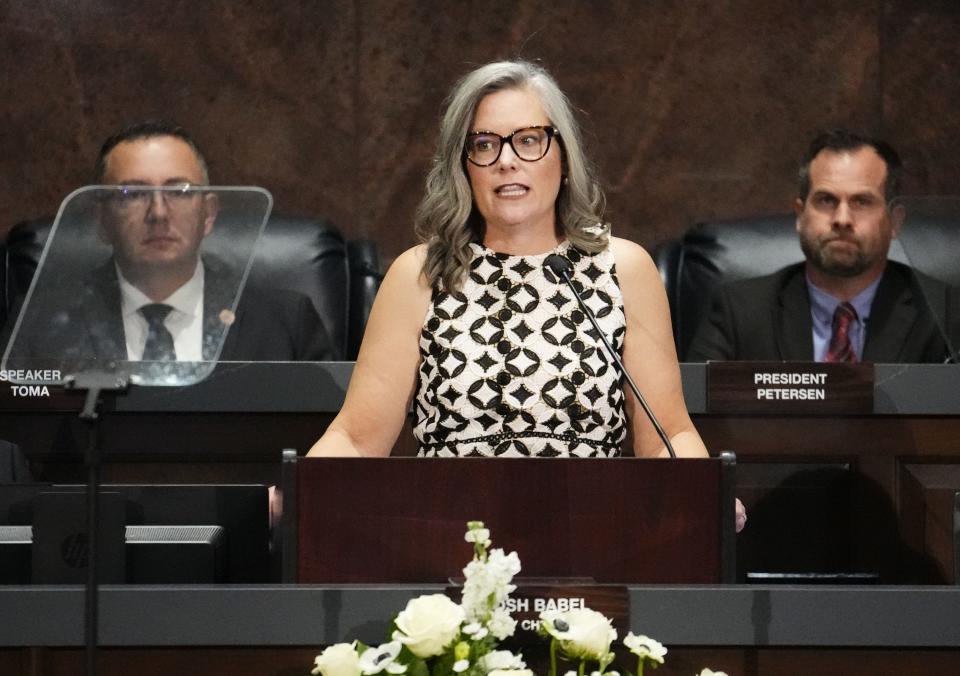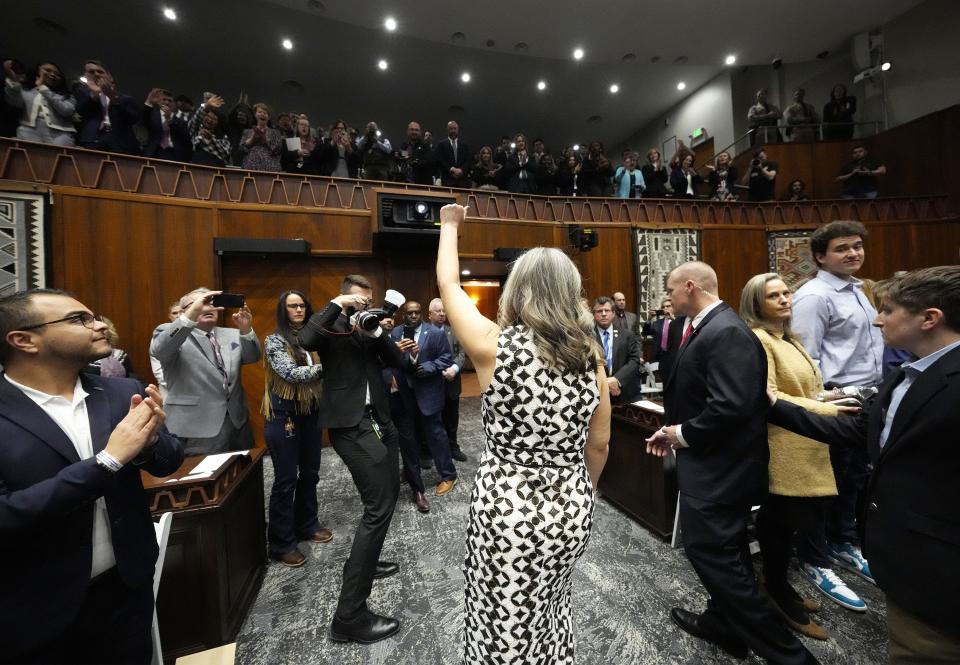Arizona State of the State: Takeaways from Gov. Katie Hobbs’ policy outline
- Oops!Something went wrong.Please try again later.
- Oops!Something went wrong.Please try again later.
Arizona has just entered its second year of divided government. And based on the speeches and the comments at Gov. Katie Hobbs' State of the State address, the divide between Republican and Democratic proposals is still wide.
But there were some areas of possible bipartisan agreement.
Hobbs demonstrates a learning curve in year two
Hobbs appeared to be more comfortable addressing lawmakers with a year of divided government behind her, and GOP lawmakers noted a changed tone in her second address.
Rep. David Livingston, R-Peoria, said Hobbs’ speech seemed more professional than her first, what he attributed to the learning curve of working in divided government.
Was it less political?
“A little bit, yes,” Livingston said. “She realizes she has to work with the Republicans or she gets nothing. But she was political where she needed to be for her base, and it made her base happy. She won’t get any of that, but she got to speak about it.”
House Speaker Ben Toma, R-Glendale, said last year that Hobbs’ first State of the State sounded like “a DNC speech,” referring to the Democratic National Committee.
“This one sounded a little more gubernatorial than that,” Toma said Monday. “But there are definitely moments where it came back straight to that, almost like a campaign speech."
Those issues included abortion access and pledges to curtail the state’s private school voucher program, Toma said.
Hobbs’ physical demeanor in the House of Representatives, where she once served as a lawmaker, seemed to reflect her comfort. In her first year, she delivered her State of the State and immediately left the chamber through a back door.
This year, she followed tradition and left down the center aisle of the chamber, between lawmakers of both parties.

Republican leaders offer sharp criticism after pre-session nods to pragmatism
House Speaker Ben Toma and Senate President Warren Petersen criticized Hobbs and her plans both before and after her speech.
As Hobbs was waiting to enter the House to outline her priorities, Republican leaders preempted her address by first outlining theirs. It was something no one could recall happening before, on a day when the governor is the focal point of the proceedings.
“No, never,” said former Gov. Jan Brewer, a Republican, when asked if such speeches had been offered previously.
Later, Petersen and Toma in a video rebutting Hobbs’ speech said they have “grave concerns” about her leadership, which they said represents “big government overreach.”
The pair roundly blasted her policies on education and crime-fighting. They accused her of driving fentanyl deaths in Arizona with her “open border” record, although opioid overdoses in Arizona declined in 2023 for the second year in a row.
Toma made it clear Hobbs’ plans to add accountability and transparency to the universal school voucher program were a non-starter, saying he won’t allow “anything that would roll back or eliminate the ESA program."
Toma later told The Arizona Republic that Hobbs and Republicans may agree on some aspects of border policy.
“Now we’re at least talking the same way, so let’s see if we can get there,” he said. “But we’ve been screaming about that for years now.”
Water policy offers bipartisan common ground

Water policy has emerged as a potential area where Republicans and Democrats could work together.
Rep. Tim Dunn, R-Yuma, credited the governor for working hard to find a way to allow homebuilding in the Phoenix area suburbs to continue even if there isn’t an assured 100-year supply of groundwater. Hobbs had said before her speech that, given Arizona’s housing crisis, more homebuilding is needed.
Dunn also said he sees a willingness to work on ways to give rural communities more of a say on their groundwater use. Proposals to do just that have failed to advance it the last three years, he said, so a new approach is needed. It's an issue that Hobbs’ Water Policy Council has studied and could provide a base from which to start.
Rep. Gail Griffin, the chair of the House committee that handles water issues, said she’s not interested in changing a law that allows lots to be split into five parcels without requiring proof of a water supply.
“We need to address bad players who are acting in concert to get around subdivision laws,” Griffin, R-Hereford, said. But, she added: “There’s nothing wrong with selling a piece of property and if it’s broken into five parcels or less, leave them alone.”
The state budget: All agree cuts are needed, but where?
With a $400 million deficit already dogging the state budget and a bigger hole expected for next year, there is widespread agreement that Hobbs and the Legislature will have to agree on budget cuts. No one is talking about new, pricey programs.
The governor acknowledged that in her speech. But she made it clear there are some reductions she won’t tolerate.
“We will rein in wasteful spending without sacrificing public safety and public education,” she said.
Senate President Petersen suggested budget cuts could benefit Arizonans.
“Shrinking government and putting more money in the pockets of our citizens who are reeling from inflation” is a GOP priority, he said. Republicans, led by the Freedom Caucus, last year successfully folded tax rebates into the budget. That amounted to checks of up to $750 arriving in the accounts of families with dependent children.
Hobbs weighs in — briefly — on Prop 123 and teacher pay
Hobbs signaled support for an extension of Proposition 123, though she’s not quite in line with a plan Republicans have backed to earmark the revenues solely to public teacher salaries.
Republican lawmakers proposed asking voters to continue tapping the state's land trust fund, with the money channeled to $4,000 teacher raises. But Hobbs said she’d like to see more compensation for support staff and investments in school safety.
“By working together to strengthen Prop 123, we will prove to Arizona parents and students that we’re building the world-class public education system they deserve, and that our state needs for the future," Hobbs said. "We must not let this opportunity pass us by.”
Rep. Matt Gress, a former teacher, was one of just a couple Republicans to give Hobbs a standing ovation at any point in her 45-minute speech. The Phoenix Republican rose from his chair when she discussed increasing teacher salaries.
But he said he found her brief reference to Proposition 123 lacking. Gress was the budget director for Republican Gov. Doug Ducey, Hobbs' predecessor, who first pitched Prop 123 to voters.
“I was surprised to hear that she didn’t go as in depth into the Prop 123 renewal,” he said, noting he would not support including raises for support staff. It would be a "travesty" to lose focus on providing raises that could put qualified teachers in every classroom, he said.
Rep. Teresa Martinez, R-Casa Grande, said she sees room for bipartisan agreement on Proposition 123. Martinez, the House whip, didn't see a problem in expanding increased pay to other school personnel.
"I think that would be OK for some of the paraprofessionals and the bus drivers and the cafeteria workers," she said.
This article originally appeared on Arizona Republic: Gov. Hobbs delivered her second State of the State. Here’s what to know

